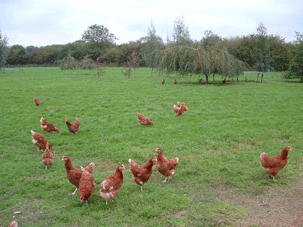New advice for managing Bovans Goldline layers

Layer breeder Joice and Hill has developed new guidelines on managing one of its key breeds, which is set to bring many benefits to egg producers, as Nick Bailey explains
Tweaking the management of Bovans Goldline layers not only reduces feed costs, but it also helps avoid egg size running out of control later in lay and can enhance bird health.
This breed has been specifically bred with robustness in mind, which means it is ideal for free range and multi-age sites. This coupled with its good early egg size and appetite means that producers can feed lower spec diets earlier, such as feeding a Layer 2 type diet from housing.
In fact we find that high density diets, especially those rich in methionine and linoleic acid, can actually be detrimental since they push egg size too high and reduce growth.
This is significant when considering that high protein diets of 18-19% crude protein have become increasingly common in the free-range sector and are sometimes used for prolonged periods post housing. While they may aid growth in the first month after housing, it is often tempting to keep the birds on these diets in an effort to boost egg size and body weight.

If intake is normal and flock uniformity is acceptable then it is questionable whether high protein diets are needed with the Bovans after this initial post-housing period. It should be stressed that body weight, feed intake, production and egg size should all be monitored weekly in order to make the correct decisions and to ensure successful and proactive management of the flock.
We find that the most consistent results come from flocks that have been brought into lay on breed target and egg size. Not pushing for egg size with nutrition will result in better production and shell quality later on and this is healthier for the hen.
Many packers are looking for eggs at the smaller end of large in the free range segment and would rather have an extra three dozen mediums and far less broken eggs than an extra 20 extra large eggs per bird and the shell quality problems associated with the larger sizes.
Aside from the extra cost of up to £10/t, these diets can cause excessive egg weight, fat deposition and wasteful metabolism and potentially lead to feather loss, stress and production problems.
Furthermore, excess protein in the gut is thought to be involved in digestive tract problems such as brachyspira (see p26 August) and can lead to enteritis.
Dropping the specification of the diet can also make it easier for compounders to incorporate higher levels of crude fibre, such as replacing a proportion of soya and wheat with sunflower meal.
For years, fibre has been known to improve gut health, reduce stress and improve feather retention. Recent studies show that birds fed diets containing high fibre had 20 times less feather material in their gizzards than those on the low fibre control diets. This indicates that feather loss may be directly linked to feather consumption and a need for fibre.
This ties in with experience we have seen when feeding the high spec rocket fuel-type diets to push for egg size resulted in feather loss.
In conclusion, by tweaking the management of Goldline layers and opting for a lower spec diet by changing through the layer diets 6-7 weeks earlier, producers can see good, if not better production. And bird health also benefits.
Bovans birds reap dietary benefits
Bovans Goldline birds fed a less concentrated diet are less vulnerable to disease challenge and are less likely to lose control of egg size.
These benefits are highlighted when comparing two Bovans flocks. Flock A, which comprises of 6000 birds on a unit in Herefordshire, was fed lower spec diets from housing while Flock B, 16000 birds on a separate unit in Cheshire, received a the more traditional higher spec diets.
Flock B saw good egg size early on and subsequently, lost control of size with eggs up to 70g at one point. As a result, the producer saw more problems with a couple of wobbles in production due to disease challenges. This is fairly typical of what we are seeing with other flocks in the UK.
So while Flock B saw 2g more egg size, egg numbers were 14 lower at 308. In contrast, the producer with Flock A didn’t push egg size early on and, consequently, birds remained healthier and saw good production. More importantly, Flock A saw a better margin/bird.
